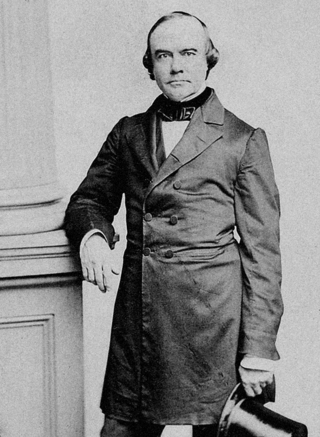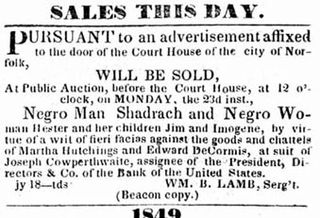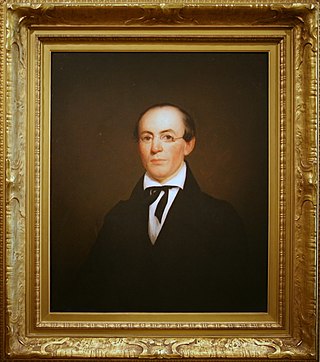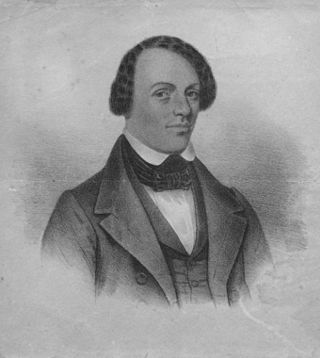
Abolitionism, or the abolitionist movement, is the movement to end slavery. In Western Europe and the Americas, abolitionism was a historic movement that sought to end the Atlantic slave trade and liberate the enslaved people.

William Lloyd Garrison was a prominent American Christian, abolitionist, journalist, suffragist, and social reformer. He is best known for his widely read antislavery newspaper The Liberator, which he founded in 1831 and published in Boston until slavery in the United States was abolished by constitutional amendment in 1865. Garrison promoted "no-governmentism" and rejected the inherent validity of the American government on the basis that its engagement in war, imperialism, and slavery made it corrupt and tyrannical. He initially opposed violence as a principle and advocated for Christian nonresistance against evil; at the outbreak of the Civil War, he abandoned his previous principles and embraced the armed struggle and the Lincoln administration. He was one of the founders of the American Anti-Slavery Society and promoted immediate and uncompensated, as opposed to gradual and compensated, emancipation of slaves in the United States.
The source of Garrison's power was the Bible. From his earliest days, he read the Bible constantly and prayed constantly. It was with this fire that he started his conflagration. ... So also, a prejudice against all fixed forms of worship, against the authority of human government, against every binding of the spirit into conformity with human law, – all these things grew up in Garrison's mind out of his Bible reading.

The Liberator (1831–1865) was a weekly abolitionist newspaper, printed and published in Boston by William Lloyd Garrison and, through 1839, by Isaac Knapp. Religious rather than political, it appealed to the moral conscience of its readers, urging them to demand immediate freeing of the slaves ("immediatism"). It also promoted women's rights, an issue that split the American abolitionist movement. Despite its modest circulation of 3,000, it had prominent and influential readers, including Frederick Douglass, Beriah Green and Alfred Niger. It frequently printed or reprinted letters, reports, sermons, and news stories relating to American slavery, becoming a sort of community bulletin board for the new abolitionist movement that Garrison helped foster.

Benjamin Robbins Curtis was an American lawyer and judge. He served as an associate justice of the United States Supreme Court from 1851 to 1857. Curtis was the first and only Whig justice of the Supreme Court, and was also the first Supreme Court justice to have a formal law degree. He is often remembered as one of the two dissenters in Dred Scott v. Sandford (1857).

Lemuel Shaw was an American jurist who served as chief justice of the Massachusetts Supreme Judicial Court (1830–1860). Prior to his appointment he also served for several years in the Massachusetts House of Representatives and as a state senator. In 1847, Shaw became the father-in-law of author Herman Melville. He ruled on prominent cases involving slavery, segregation, and religion.

Shadrach Minkins was an African-American fugitive slave from Virginia who escaped in 1850 and reached Boston. He also used the pseudonyms Frederick Wilkins and Frederick Jenkins. He is known for being freed from a courtroom in Boston after being captured by United States marshals under the Fugitive Slave Act of 1850. Members of the Boston Vigilance Committee freed and hid him, helping him get to Canada via the Underground Railroad. Minkins settled in Montreal, where he raised a family. Two men were prosecuted in Boston for helping free him, but they were acquitted by the jury.

The Massachusetts Anti-Slavery Society, headquartered in Boston, was organized as an auxiliary of the American Anti-Slavery Society in 1835. Its roots were in the New England Anti-Slavery Society, organized by William Lloyd Garrison, editor of The Liberator, in 1831, after the defeat of a proposal for a college for blacks in New Haven.
Harry v. Decker & Hopkins (1818) was a freedom suit in which the Supreme Court of Mississippi ruled that the three slaves in the case were freed based on prior residence in the Northwest Territory, established as free in 1787. Mississippi's court was the first in the South to rule on this issue and created a precedent in transit cases that was widely observed by slave state courts.

Lemmon v. New York, or Lemmon v. The People (1860), popularly known as the Lemmon Slave Case, was a freedom suit initiated in 1852 by a petition for a writ of habeas corpus. The petition was granted by the Superior Court in New York City, a decision upheld by the New York Court of Appeals, New York's highest court, in 1860 on the eve of the Civil War.

The Boston Female Anti-Slavery Society (1833–1840) was an abolitionist, interracial organization in Boston, Massachusetts, in the mid-19th century. "During its brief history ... it orchestrated three national women's conventions, organized a multistate petition campaign, sued southerners who brought slaves into Boston, and sponsored elaborate, profitable fundraisers."
The Cincinnati riots of 1836 were caused by racial tensions at a time when African Americans, some of whom had escaped from slavery in the Southern United States, were competing with whites for jobs. The racial riots occurred in Cincinnati, Ohio, United States in April and July 1836 by a mob of whites against black residents. These were part of a pattern of violence at that time. A severe riot had occurred in 1829, led by ethnic Irish, and another riot against blacks broke out in 1841. After the Cincinnati riots of 1829, in which many African Americans lost their homes and property, a growing number of whites, such as the "Lane rebels" who withdrew from the Cincinnati Lane Seminary en masse in 1834 over the issue of abolition, became sympathetic to their plight. The anti-abolitionist rioters of 1836, worried about their jobs if they had to compete with more blacks, attacked both the blacks and white supporters.

Freedom suits were lawsuits in the Thirteen Colonies and the United States filed by slaves against slaveholders to assert claims to freedom, often based on descent from a free maternal ancestor, or time held as a resident in a free state or territory.
Somerset v Stewart (1772) 98 ER 499 is a judgment of the English Court of King's Bench in 1772, relating to the right of an enslaved person on English soil not to be forcibly removed from the country and sent to Jamaica for sale. Lord Mansfield decided that:
The state of slavery is of such a nature that it is incapable of being introduced on any reasons, moral or political, but only by positive law, which preserves its force long after the reasons, occasions, and time itself from whence it was created, is erased from memory. It is so odious, that nothing can be suffered to support it, but positive law. Whatever inconveniences, therefore, may follow from the decision, I cannot say this case is allowed or approved by the law of England; and therefore the black must be discharged.

George Washington Latimer was an escaped enslaved person whose case became a major political issue in Massachusetts.

In the United States, abolitionism, the movement that sought to end slavery in the country, was active from the late colonial era until the American Civil War, the end of which brought about the abolition of American slavery through the Thirteenth Amendment to the United States Constitution.
The Abolition Riot of 1836 took place in Boston, Massachusetts (U.S.) in the Massachusetts Supreme Judicial Court. In August 1836, Eliza Small and Polly Ann Bates, two enslaved women from Baltimore who had run away, were arrested in Boston and brought before Chief Justice Lemuel Shaw. The judge ordered them freed because of a problem with the arrest warrant. When the agent for their enslaver requested a new warrant, the spectators—mostly African-American women—rioted in the courtroom and rescued Small and Bates.

Samuel Edmund Sewall (1799–1888) was an American lawyer, abolitionist, and suffragist. He was one of the founders of the Massachusetts Anti-Slavery Society in 1831, lent his legal expertise to the Underground Railroad, and served a term in the Massachusetts Senate as a Free-Soiler.

Ellis Gray Loring was an American attorney, abolitionist, and philanthropist from Boston. He co-founded the New England Anti-Slavery Society, provided legal advice to abolitionists, harbored fugitive slaves in his home, and helped finance the abolitionist newspaper, the Liberator. Loring also mentored Robert Morris, who went on to become one of the first African-American attorneys in the United States.
Thankful Southwick was an affluent Quaker abolitionist and women's rights activist in Boston, Massachusetts. Thankful was lifelong abolitionist who joined the Boston Female Anti-Slavery Society in 1835 with her three daughters. She was present at both the 1835 Boston Mob and the Abolition Riot of 1836. During the 1840 schism in the Boston Female Anti-Slavery Society, Thankful sided with the Westons, Chapmans, Childs, Sergeants, and other radical Garrisonians to reestablish the Boston Female Anti-Slavery Society. She also later joined the New England Non Resistance Society. She held several elected offices within the Boston Female Anti-Slavery Society, including counselor in 1837, as well as President in 1840, 1841, 1842, and 1844. Thankful was also involved in the women's rights movement and was an attendee and signer of the call of the first National Women's Rights Convention held in Worcester, Massachusetts, in 1850. Thankful and Joseph Southwick's house was both a gathering place for fellow abolitionists and a stop on the Underground Railroad for fugitive slaves. During her years of activism in Boston, Thankful and her family were closely acquainted with notable abolitionists and women 's rights activists, including William Lloyd Garrison, Elizabeth Cady Stanton, Frederick Douglass, Lydia Maria Child, Maria Weston Chapman, and George Thompson.














